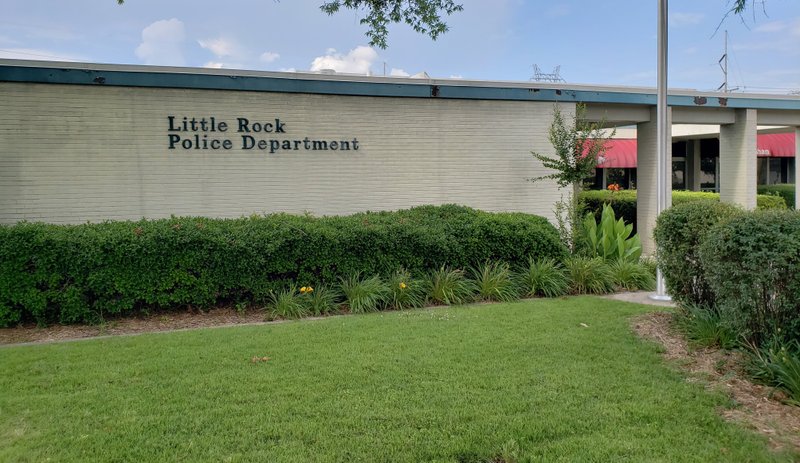Little Rock police leaders last week outlined plans for a centralized space for their intelligence-gathering and crime-reporting technology that they call the real-time crime center, an idea inspired by visits to departments in other cities in the region.
The center, which will be located in the department’s proposed new headquarters, is a “game-changer” in the way city police officers handle crime information, said Assistant Chief Heath Helton, who is spearheading the project.
“The real-time crime center will affect every part of this city,” Helton said, and also help out agencies such as the Little Rock Fire Department and MEMS with dispatching their personnel.
The department plans to move into the building across the street from its 700 West Markham headquarters by July, after renovations are complete, Chief Keith Humphrey said.
Helton and Humphrey spoke at a quarterly review meeting of the department’s Northwest patrol division Thursday evening.
Details were scant, but Helton sketched the outlines of a single location where the department could consolidate most of its tech and improve their ability to do tasks ranging from identifying crime trends to handling online crime reports and working with the department’s forthcoming mobile application.
The idea came largely from a visit to New Orleans, Helton said, where he and other police officials saw the city’s Real-Time Crime Center.
New Orleans’ Real-Time Crime Center was established in 2017 and uses technology, mainly cameras, to provide first responders such as police and paramedics with relevant information about the calls they are responding to, according to the city’s website.
The idea is to make police more efficient in their work, giving them the chance to be more visible in the community and build trust, which in turn leads to community members coming forward as witnesses, leading to more arrests and convictions and a safer city, according to an infographic on the site.
The center in New Orleans uses cameras placed across the city, “covering every neighborhood,” as well as license plate scanners, but does not use facial recognition technology, the site clarifies. The footage is stored for 30 days unless selected and archived by police.
Helton did not talk specifically about installing more surveillance cameras or new use of ones already in place, but did mention that the center would be a good place to house new surveillance programs. He specifically mentioned the potential for a partnership in Little Rock similar to Detroit’s Project Green Light, in which business owners in the city provide police with live access to their security cameras to get footage to police more quickly.
Answering a question from Ward 7 Director B.J. Wyrick at the Thursday meeting, Humphrey acknowledged that the new center has not been given a line item in the city’s budget yet, but said that Mayor Frank Scott Jr. is on board with the project.
“That conversation is taking place,” Humphrey said.
Helton added that the department plans to seek money from law enforcement grants to supplement the cost the city would pay.
Wyrick could not be reached by phone for further comment about the police’s plans.
Humphrey and Helton did not provide an estimated cost for the center Thursday, and police spokesman Mark Edwards said that he wasn’t sure if the department had an estimated cost yet.
Edwards could say that the cost of outfitting the proposed crime center is separate from the cost of renovating the new headquarters building.
Despite the question of money, Humphrey was optimistic, and said that they had run some trial runs and were excited with the results, though he didn’t say what that entailed.
“I have no doubt we’ll be able to fund it,” Humphrey said.
Some version of the center will be up and running when the department moves into its new headquarters in July, Helton said.
Before turning his attention to the digital intelligence center, Helton was the face of the department’s efforts to create an online crime-reporting system last fall. The idea was to make it easy and quick for anyone with a computer or a smartphone to report non-life-threatening crimes or information about a crime.
Residents can report more than a dozen non-emergency crimes or public nuisances, leaving 911 calls for emergencies that police need to be able to focus on and respond to quickly, Helton said.
The online reporting capability will be bundled into the YourLRPD app when it launches, which will hopefully be by the end of May, said Maj. Casey Clark, who has been working on the project with company AtlasOne for about a year.
“We’ve been running testing on it and, boy, it’s exciting stuff,” Clark said, demonstrating the process of getting information about a crime in the city by just tapping a marker on a map.
Those markers are generated using the department’s existing dispatch technology, and will give residents a near-real-time idea of what crime is happening in the city.
They can also file an online report, submit tips — anonymously if desired — to police using text, photos or videos and get in touch with police personnel such as Edwards for further questions.
Clark said the forthcoming app is “probably one of the best things we’ve done with the Police Department in a long time.”

